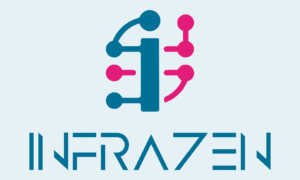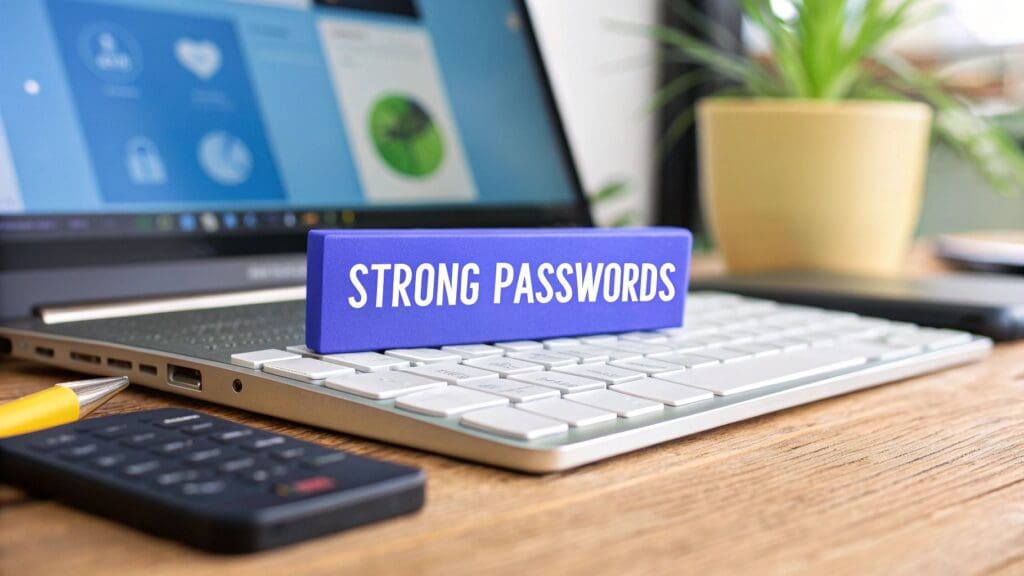Think of your password as the digital lock on your studio door. Creating a strong one is your first and most important line of defence against anyone trying to break in.
A genuinely strong password isn't just about swapping an 'a' for an '@'. It's about creating something long, complex, and completely unique that’s easy for you to remember but a nightmare for an attacker to guess.
Why Strong Passwords Are Not Optional
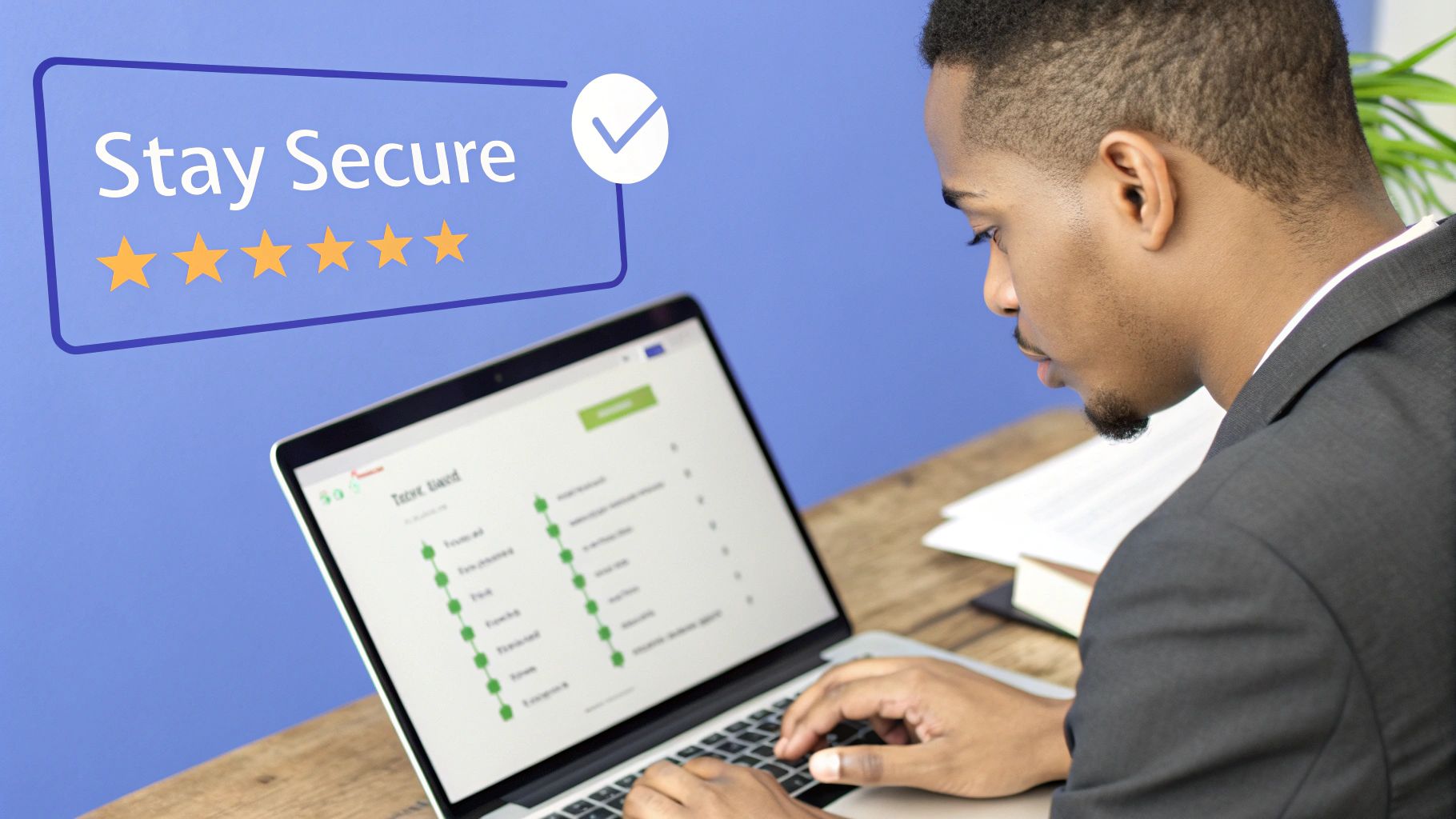
It's tempting to see password security as just another tedious chore, but that’s precisely the mindset cybercriminals rely on. A single weak or reused password can become a master key, giving them access not just to one account, but to your entire digital life—from your client files to your bank account.
Your email is often the central hub for password resets and account access, so it's a prime target. Learning how to secure your email account is a critical step in protecting everything else.
The fallout from a breach isn't just theoretical. For creative professionals trusted with sensitive client data, it can be devastating, leading to financial loss, identity theft, and serious damage to your professional reputation.
The Real-World Risk in the UK
This isn't a distant threat; it’s happening right here. A recent Cyber Security Breaches Survey revealed that a staggering 43% of UK businesses experienced a cyber breach or attack, with phishing being the most common culprit. These attacks succeed by exploiting weak credentials, allowing attackers to pivot from one compromised account to an entire network.
Viewing password security as a fundamental personal responsibility, rather than an IT problem, is the first step towards protecting yourself. Your password isn't just a login; it's the digital lock on your front door.
Thinking of your password as a "set it and forget it" task is a major mistake. It's an ongoing practice in personal digital security.
To give you a clearer picture, here’s a quick guide on what separates a weak password from a strong one.
Quick Guide to Strong Password Creation
| Characteristic | Weak Password Example | Strong Password Recommendation |
|---|---|---|
| Length | P@ssw*rd (8 chars) |
GreenElephantDances@Midnight! (30+ chars) |
| Predictability | Summer2025! |
Correct-Horse-Battery-Staple-7! |
| Uniqueness | Reusing the same password | A unique password for every single account |
Use this as a simple gut-check. If your current passwords look more like the examples in the middle column, it’s time for an upgrade.
The Real Anatomy of an Unbreakable Password
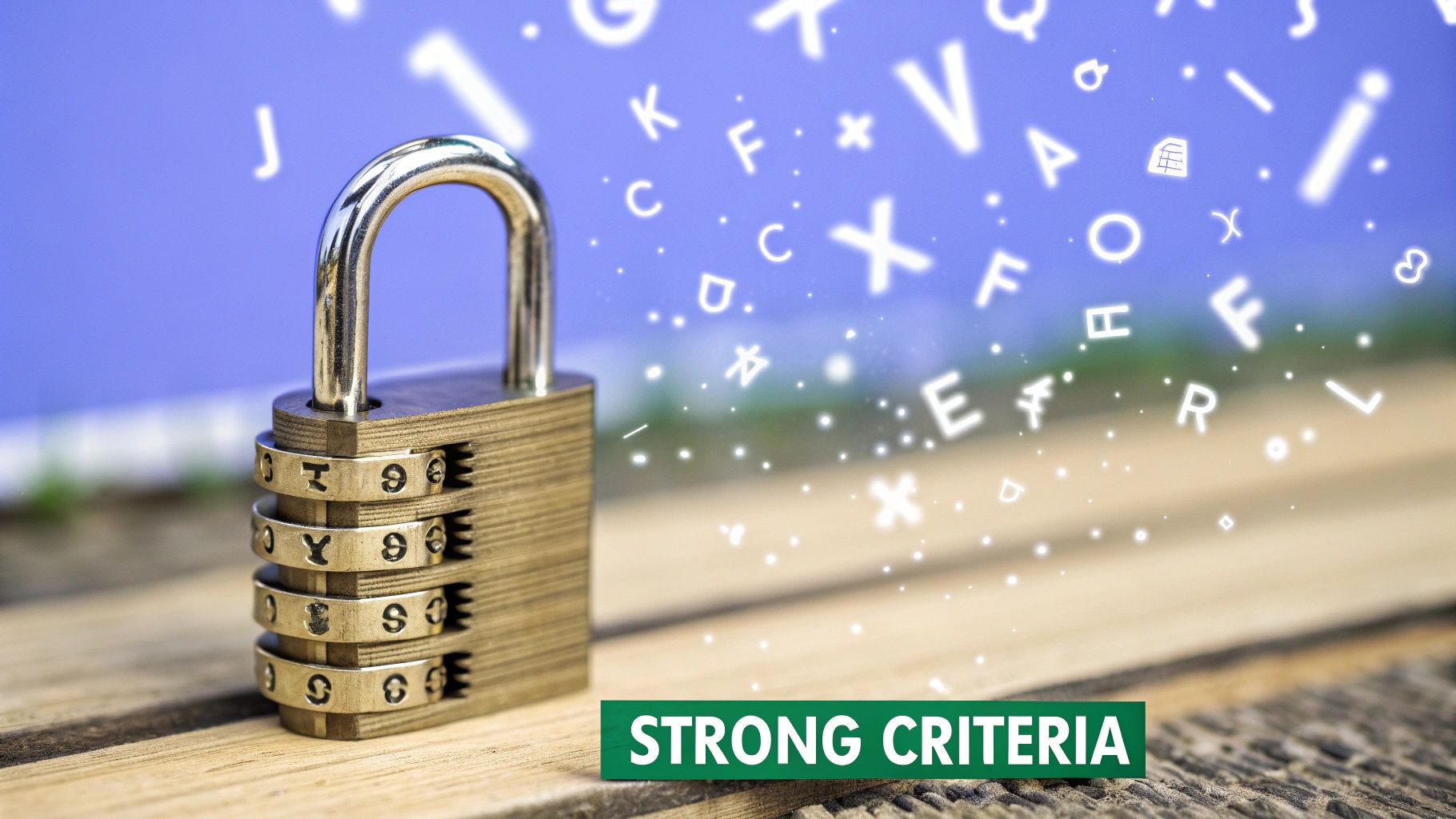
To build a genuinely strong password, you need to stop thinking defensively and start thinking like an attacker. They aren't sitting there guessing Fluffy123. They’re running sophisticated software that chews through billions of combinations every second. This is precisely why predictable patterns are your greatest weakness.
A lot of people think they're being clever by swapping letters for numbers, turning Password into P@ssw0rd. While it feels like a smart move, these are the absolute first things a cracking tool checks for. Modern hacking algorithms are built to spot these common substitutions instantly, making them almost completely pointless.
Length Over Complexity
If there's one thing to take away, it's this: length is the single most critical factor in a password's strength. Every single character you add makes the number of possible combinations grow exponentially. It's the difference between a puzzle that takes minutes to solve and one that would take centuries.
An 8-character password like Tr0ub4dor&, packed with complexity, can still be cracked in a matter of hours, if not minutes. But a longer, simpler passphrase can resist attacks for years. The sheer number of possibilities in a long string simply overwhelms the character complexity of a shorter one.
For a deeper dive, the specialists behind these 7 Tips for Crafting a Strong Password offer some excellent, practical advice.
The principle is simple: a longer password creates a much bigger haystack for an attacker to search through. It makes finding the needle statistically improbable, if not impossible.
Avoiding Predictable Patterns
Beyond the obvious _@_ for _a_ substitutions, you have to steer clear of other weak patterns that attackers are programmed to exploit. These are dead giveaways.
- Keyboard Walks: Typing keys right next to each other, like
qwertyorasdfghjkl. They look random, but they’re not. - Common Phrases: Using cliché words like
password,admin, or the classic123456. - Personal Information: This is a big one. Never use your name, birthday, pet’s name, or anything else that can be easily found out about you.
What might have felt clever a few years back is now dangerously easy to crack. As we break down in our guide, your clever password isn't clever anymore. Real strength comes from genuine randomness and length, not from tricks that have long been figured out.
Switching to Passphrases for Smarter Security
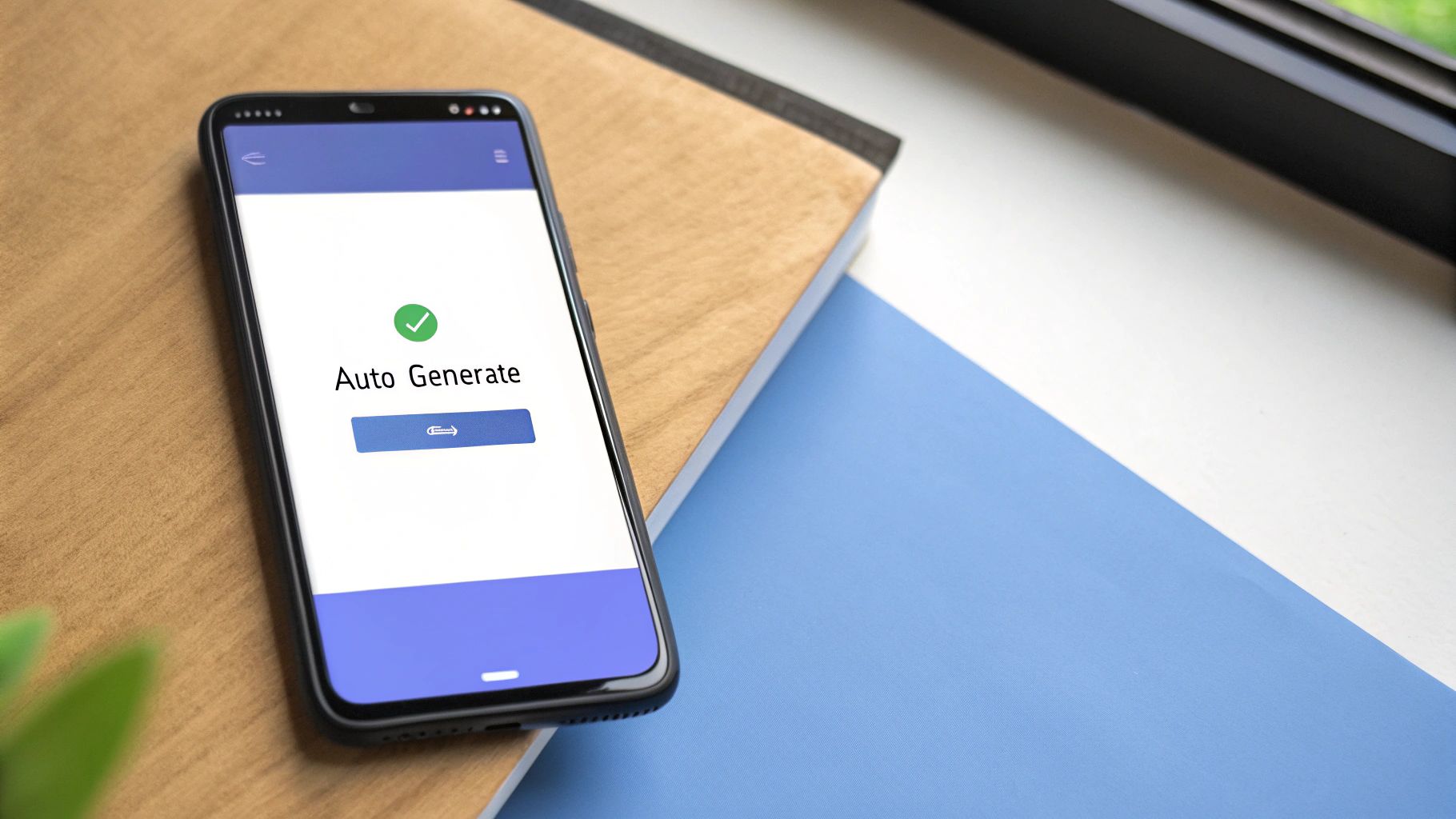
Let's be honest, trying to remember passwords like S3cur!TyR0cks# is a nightmare. As we've seen, those predictable symbol-for-letter swaps don't offer much real protection anymore. There’s a much better way that's both stronger and, surprisingly, easier to handle: the passphrase.
Instead of a short, complicated jumble, a passphrase uses a sequence of random words. The magic is in the length. A simple four-word phrase like Correct-Horse-Battery-Staple is exponentially more secure than a typical 10-character complex password. Its sheer length creates a mathematical headache for brute-force attacks, making it incredibly tough to crack, yet it’s something a human can actually remember. It’s a total game-changer.
How to Create a Passphrase That Actually Works
The trick to a strong passphrase is true randomness. Don't grab a line from your favourite film or a song lyric; hackers have entire dictionaries full of that stuff. You need to generate a sequence of words that are genuinely unconnected. The classic "diceware" method, where you roll dice to pick words from a list, is a great way to remove any personal bias.
Another solid approach is to create a strange mental image that’s unique to you. Think of a bizarre, vivid scene that nobody else would ever guess.
- Example 1: A purple giraffe juggling four glowing teapots. This becomes
PurpleGiraffeJuggling4Teapots!. - Example 2: A grumpy badger eating spicy tacos on Tuesday. This could be
GrumpyBadgerSpicyTacosTuesday2.
These aren't just secure because of their length; they're far easier to bring to mind than a string of abstract characters and symbols.
A great passphrase gives you the immense security of length combined with the ease of memorability. It’s a low-effort, high-reward strategy for protecting your digital work.
While passphrases are a massive step up, the world of authentication is already moving on. If you're curious about what's next, it's worth taking a look at the shift towards ditching passwords for more secure passkeys.
Right, so you’ve got a system for creating strong, unique passwords. But let's be honest, securely managing dozens of them is a whole different ball game. This is where a dedicated password manager becomes one of the most valuable tools in your kit.
Instead of trying to memorise everything, scribbling notes on paper, or using those risky browser auto-save features, a password manager acts as a high-security digital vault for all your credentials. It’s designed to take the mental load off. It safely stores everything from client portal access and software licences to your social media logins, and can automatically fill them in for you with a single click.
That convenience alone is a game-changer because it removes the temptation to reuse weak passwords – one of the biggest security mistakes people make.
Automated Security That Works for You
Beyond just being a secure storage locker, good password managers are packed with powerful tools to keep your accounts safe. Their built-in generators are perfect for creating genuinely strong passwords on the fly. No more thinking up clever phrases; just click a button and get a long, random string of characters that's practically impossible for an attacker to crack.
This image really drives home how quickly a passphrase gets stronger with every word you add.
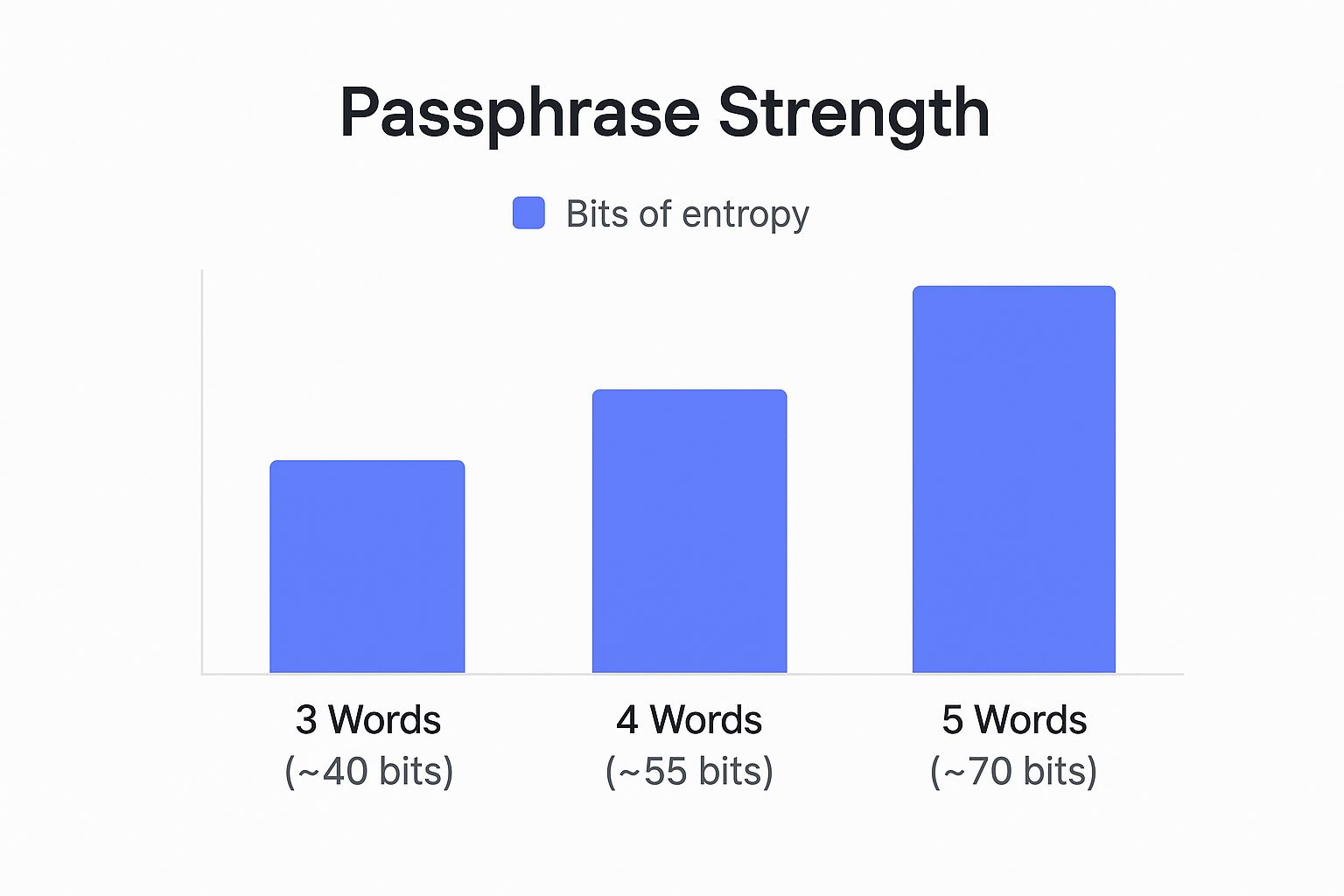
Look at that jump. The difference between a three-word and a five-word phrase isn't just a small step up; it's an exponential leap in security, making it a much more robust choice.
Many managers also audit your existing passwords, flagging any that are weak, have been reused across multiple sites, or have shown up in a known data breach. This is like having a security expert constantly looking over your shoulder, letting you fix vulnerabilities before they can be exploited.
Adopting a password manager isn't just about convenience. It's about putting a systematic, secure process in place for your entire digital identity. It is the single most effective step you can take to upgrade your online security.
Most modern password managers now operate on what’s called a zero-knowledge architecture. This is a critical feature. It means your data is encrypted and decrypted locally on your device using your one-and-only master password. The upshot? Not even the password manager company can get into your vault. Your information stays completely private and secure from any outside threats.
To see why this is such a big deal, let’s compare the old way of doing things with the new.
Manual Management vs Password Manager
| Feature | Manual Management | Using a Password Manager |
|---|---|---|
| Password Strength | Often weak and simple to make them memorable. | Generates long, random, and unique passwords that are nearly impossible to crack. |
| Uniqueness | High tendency to reuse passwords across multiple sites. | Creates a unique, strong password for every single account. |
| Storage Method | Risky methods like spreadsheets, notes, or just memory. | Securely stored in an encrypted vault, protected by a master password. |
| Convenience | Tedious and prone to forgetting, leading to password resets. | Auto-fills logins across devices, saving time and hassle. |
| Security Audits | None. You won't know if a password is weak or compromised. | Proactively flags weak, reused, or breached passwords for you to update. |
| Access | Limited to wherever you've stored your notes (or your brain). | Syncs across all your devices (computer, phone, tablet) for easy access. |
As you can see, there’s really no contest. While managing passwords manually might feel easier in the short term, it introduces massive security risks and ends up being far less convenient. A password manager offers a robust, organised, and far more secure way to handle your digital life, freeing you up to focus on your creative work.
Adding a Layer of Security with Multi-Factor Authentication
Even a fortress-like password isn't completely unbreakable. That’s where Multi-Factor Authentication, or MFA, comes in. Think of it as the essential second lock on your digital door—a vital security layer that stops intruders even if they somehow get their hands on your password.
It works by demanding more than one form of proof that you are who you say you are before granting access. Instead of just needing something they know (your password), an attacker would also need something they physically have, like your phone. That extra step makes a world of difference.
Understanding the Factors of Authentication
At its core, MFA combines at least two out of three distinct types of credentials to verify your identity. This layered approach is the bedrock of modern account security.
- Something you know: This is the classic factor—your password, a passphrase, or a PIN.
- Something you have: This is a physical item you possess. It could be your smartphone receiving a code, an authenticator app, or a dedicated hardware security key.
- Something you are: This involves biometrics—unique biological traits like your fingerprint, face ID, or a retina scan.
For creative professionals, whose entire reputation can hang on protecting client data and intellectual property, enabling MFA isn't just a good idea; it's fundamental.
MFA is the security world's equivalent of needing both a key and a keycard to enter a secure room. One without the other is useless, drastically reducing the chances of a successful break-in.
The pressure to adopt stronger measures like this is only growing. With UK organisations facing security incidents—21% monthly and 18% weekly—password technology has had to evolve. We've moved beyond simple text to embrace MFA, biometrics, and passkeys, all driven by increasing regulatory demands and more sophisticated threats. You can discover more insights on how password security is evolving to meet these new challenges on securitybrief.co.uk.
Your Top Password Security Questions, Answered
Even when you've got a decent password strategy in place, a few nagging questions always seem to surface. It’s one thing to know the rules, but another to feel confident applying them day-to-day. Let's clear up some of the most common sticking points I hear from creative teams.
How Often Should I Really Be Changing My Passwords?
Forget everything you were told about changing passwords every 90 days. That advice is officially a relic. The UK's National Cyber Security Centre (NCSC) and other experts have moved on, and you should too.
The modern, and frankly more practical, approach is this: create a long, strong, and completely unique password for every single one of your accounts. Then, leave it alone. The only time you should change it is if you have good reason to believe it’s been compromised.
Why the change of heart? Because forcing people to change passwords constantly just encourages bad habits. We end up making tiny, predictable tweaks like Summer2024! to Autumn2024!, which attackers can guess in seconds. Your time is much better invested in creating one fantastic password per account and locking it down with multi-factor authentication.
Are Browser Password Managers Secure Enough?
Look, using the password manager built into Chrome or Safari is definitely a huge step up from reusing the same password everywhere. They’re convenient and get the basic job done. But when it comes to the accounts that really matter—your email, your cloud storage, your financial apps—a dedicated password manager application is in another league entirely.
Dedicated managers are built on a "zero-knowledge" encryption model. This means not even the company's own employees can see your data. It adds a crucial layer of security that lives completely outside your web browser—which is one of the most common targets for malware.
Standalone managers also pack in more powerful features, like securely sharing credentials with teammates, giving you detailed alerts if one of your passwords shows up in a breach, and working seamlessly across all your devices. For any creative professional handling client work or sensitive IP, they are the only real choice. It's one of those small, smart decisions that helps you avoid the biggest cybersecurity mistakes small companies make.
What Should I Do if I Think My Account Was Hacked?
If you get that sinking feeling that an account has been breached, don't panic, but do act fast. Time is critical.
- Change the Password Immediately: If you can still get in, change the password to something new, long, and unique. If you're already locked out, start the official account recovery process without delay.
- Turn On MFA: If you didn't have Multi-Factor Authentication enabled before, turn it on now. It's your best defence against them getting back in.
- Check for Unauthorised Activity: Scan your account for anything you don't recognise. Look for sent emails, deleted files, changed profile details, or strange posts.
- Audit Your Other Accounts: This is the step everyone forgets. If you reused that compromised password anywhere else, you have to assume those accounts are at risk too. Change those passwords right now.
Managing your digital security shouldn't be a source of stress. InfraZen Ltd specialises in creating calm, secure, and efficient IT environments for creative professionals, letting you focus on your work, not on technical worries. Find out how we can help your studio at https://infrazen.tech.
